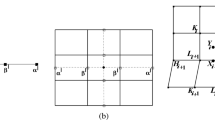Abstract
This paper constructs a new non-uniform Doo-Sabin subdivision scheme via eigen polygon. The authors proved that the limit surface is always convergent and is G1 continuous for any valence and any positive knot intervals under a minor assumption, that λ is the second and third eigenvalues of the subdivision matrix. And then, a million of numerical experiments are tested with randomly selecting positive knot intervals, which verify that our new subdivision scheme satisfies the assumption. However this is not true for the other two existing non-uniform Doo-Sabin schemes in [32, 33]. In additional, numerical experiments indicate that the quality of the new limit surface can be improved.
Similar content being viewed by others
References
Warren J and Weimer H, Subdivision Methods for Geometric Design, Morgan, Kaufmann, 2002.
Muller K, Reusche L, and Fellner D, Extended subdivision surfaces: Building a bridge between NURBS and Catmull-Clark surfaces, ACM Transactions on Graphics, 2006, 25: 268–292.
Doo D and Sabin M, Behaviour of recursive division surfaces near extraordinary points, Computer Aided Design, 1978, 10: 356–360.
Catmull E and Clark J, Recursively generated B-spline surfaces on arbitrary topological meshes, Computer Aided Design, 1978, 10: 350–355.
Loop C, Smooth subdivision surfaces based on triangles, Master’s thesis, University of Utah, 1987.
Kobbelt L, \(\sqrt 3 \)-subdivision, SIGGRAPH’ 00: Proceedings of the 27th annual conference on Computer graphics and interactive techniques, ACM Press/Addison-Wesley Publishing Co., 2000, 103–112.
Velho L and Zorin D, Quasi 4–8 subdivision, Computer Aided Geometric Design, 2001, 18: 345–358.
Velho L and Zorin D, 4–8 subdivision, Computer Aided Geometric Design, 2001, 18: 397–427.
Stam J and Loop C, Quad/Triangle subdivision, Computer Graphics Forum, 2003, 22: 1–7.
Peters J and Shiue L, Combining 4- and 3-direction subdivision, ACM Transactions on Graphics, 2004, 23: 980–1003.
Dyn N, Levin D, and Gregory J A, A four-point interpolatory subdivision scheme for curve design, Computer Aided Geometric Design, 1987, 4: 257–268.
Dyn N and Levin D, A butterfly subdivision scheme for surface interpolation with tension control, ACM Transactions on Graphics, 1990, 9: 160–169.
Zorin D, Schröder P, and Sweldens W, Interpolating Subdivision for meshes with arbitrary topology, SIGGRAPH’96: Proceedings of the 23rd Annual Conference on Computer Graphics and Interactive Techniques, ACM, New York, NY, USA, 1996, 189–192.
Kobbelt L, Interpolatory subdivision on open quadrilateral nets with arbitrary topology, Computer Graphics Forum, 1996, 15: 400–410.
Deng C and Ma W, A unified interpolatory subdivision scheme for quadrilateral meshes, ACM Transactions on Graphics, 2013, 32(3): 1–11.
Li X and Zheng J, An alternative method for constructing interpolatory subdivision from approximating subdivision, Computer Aided Geometric Design, 2012, 29(4): 474–484.
Labsik U and Greiner G, Interpolatory \(\sqrt 3 \) subdivision, Computer Graphics Forum, 2000, 19: 131–138.
Li G, Ma W, and Bao H, Interpolatory \(\sqrt 2 \)-subdivision surfaces, Proc. Geometric Modeling and Processing, 2004, 185–194.
Beccari C, Casciola G, and Romani L, A unified framework for interpolating and approximating univariate subdivision, Applied Mathematics and Computation, 2010, 216: 1169–1180.
Luo Z and Qi W, On interpolatory subdivision from approximating subdivision scheme, Applied Mathematics and Computation, 2013, 220: 339–349.
Albrechta G and Romani L, Convexity preserving interpolatory subdivision with conic precision, Applied Mathematics and Computation, 2012, 219(8): 4049–4066.
Luo Z and Qi W, On interpolatory subdivision from approximating subdivision scheme, Applied Mathematics and Computation, 2013, 220(1): 339–349.
Cirak F, Ortiz M, and Schröder P, Subdivision surfaces: A new paradigm for thin shell analysis, International Journal of Numerical Methods in Engineering, 2000, 47: 2039–2072.
Burckhart D, Hamann B, and Umlauf G, Iso-geometric finite element analysis based on Catmull-Clark subdivision solids, Computer Graphics Forum, 2010, 29(5): 1575–1584.
Dikici E, Snare S R, and Orderud F, Isoparametric finite element analysis for Doo-Sabin subdivision models, Proceedings of Graphics Interface, 2012, 19–26.
Yuan X and Tang K, Rectified unstructured T-splines with dynamic weighted refinement for improvement in geometric consistency and approximation convergence, Computer Methods in Applied Mechanics and Engineering, 2017, 316: 373–399.
Riffnaller-Schiefer A, Augsdorfera U, and Fellner D, Isogeometric shell analysis with NURBS compatible subdivision surfaces, Applied Mathematics and Computation, 2016, 272(1): 139–147.
Wei X, Zhang Y, Hughes T J, et al., Truncated hierarchical Catmull-Clark subdivision with local refinement, Computer Methods in Applied Mechanics and Engineering, 2015, 291: 1–20.
Wei X, Zhang Y, Hughes T J R, et al., Extended truncated hierarchical Catmull-Clark subdivision, Computer Methods in Applied Mechanics and Engineering, 2016, 299: 316–336.
Kang H, Li X, Deng J, et al., Truncated hierarchical Loop subdivision surfaces and application in isogeometric analysis, Computers and Mathematics with Applications, 2016, 72: 2041–2055.
Cashman T J, Augsdörfer U H, Dodgson N A, et al., NURBS with extraordinary points: High-degree, non-uniform, rational subdivision schemes, ACM Transactions on Graphics, 2009, 28(3): 1–9.
Sederberg T, Zheng J, Sewell D, et al., Non-uniform Recursive Subdivision Surfaces, SIG-GRAPH’98, 1998, 387–394.
Huang Z and Wang G, Non-uniform recursive Doo-Sabin surfaces, Computer-Aided Design, 2013, 43: 1527–1533.
Muller K, Funfzig C, Reusche L, et al., DINUS-double insertion, non-uniform, stationary subdivision surfaces, ACM Transactions on Graphics, 2010, 29: 1–21.
Li X, Finnigin T, and Sederberg T W, G1 non-uniform Catmull-Clark surfaces, ACM Transactions on Graphics, 2016, 35: 1–8.
Li X and Chang Y, Non-uniform interpolatory subdivision surface, Applied Mathematics and Computation, 2018, 274: 239–253.
Qin K and Wang H, Eigenanalysis and continuity of non-uniform doo-sabin surfaces, Proceedings of the 7th Pacific Conference on Computer Graphics and Applications, 1999, 179–186.
Peters J and Reif U, Subdivision Surfaces, Springer, 2008.
Author information
Authors and Affiliations
Corresponding author
Additional information
This research was supported by the National Natural Science Foundation of China under Grant No. 61872328, SRF for ROCS SE, and the Youth Innovation Promotion Association CAS, CAS-TWAS president’s fellowship program.
This paper was recommended for publication by Editor-in-Chief GAO Xiao-Shan.
Rights and permissions
About this article
Cite this article
Alam, M.N., Li, X. Non-Uniform Doo-Sabin Subdivision Surface via Eigen Polygon. J Syst Sci Complex 34, 3–20 (2021). https://doi.org/10.1007/s11424-020-9264-z
Received:
Published:
Issue Date:
DOI: https://doi.org/10.1007/s11424-020-9264-z




